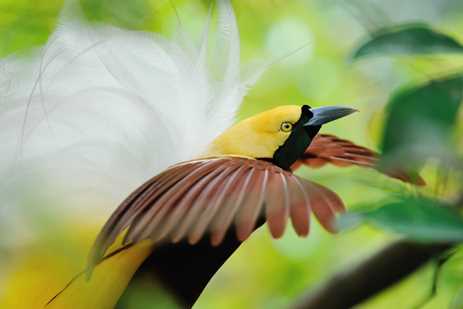Nov 2025
Watch

When immersed in the verdant vitality of a rainforest, it feels almost counterintuitive to know you stand within Earth’s oldest living ecosystem. Even after millions of years, these tropical and temperate climates remain havens of rich, if vulnerable, biodiversity. Though rainforests now cover only six percent of the planet, they are home to half of the world’s animal and plant species.
Biodiversity encompasses living things in all of their varieties—from microbes to megaflora—and directly impacts the health of a region. Regardless of size, shape, or level of sentience, each species is connected. Flora and fauna fuel and fertilize one another in a continuous loop. In the wetness and warmth of the rainforest, these cycles of nourishment happen in hyperspeed, leading to astonishing rates of endemism.
Get Inspired by Photos, Videos, Webinars, Stories, and Exclusive Offers.
Sign Up
There is beauty in this interdependence, but also great risk, because it means extinction can never be an isolated tragedy. Each fluctuation or loss of a species threatens the balance of the biome, which includes humanity, too. We rely heavily on the resources of the rainforest, especially for their roles in keeping Earth habitable—containing massive amounts of carbon, purifying water, fertilizing soil, and even mitigating disease and pest outbreaks.
From the banks of the almighty Amazon to the wilds of Alaska, here are five swaths of biodiverse rainforest, each bursting with reminders of why it's so important to honor and preserve these exquisite ecosystems.
The fertile grounds of the Amazon sustain a mind-blowing three million plant and animal species. At the rivers’ headwaters in Peru, Pacaya-Samiria National Reserve is one of the very best places to spot iconic Amazon wildlife. During the rainy season, the forest floor floods, creating an ever-changing web of wetland channels. Floating down the inky black waters of the “River of Mirrors,” look out for pink river dolphins, piranhas, and lilypads the size of inner tubes. In the trees, keep your eyes peeled for three-toed sloths and shaggy monk saki monkeys. The reserve’s 500-some bird species perform their unique song stylings, until sunset that is, when nocturnal creatures’ calls take over the rainforest symphony. By spotlight, search for frogs, caimans, fishing bats, and more members of the local nightlife.
Photo: Richard Maack
Spanning nearly 17 million acres, Tongass is the world’s largest intact temperate rainforest—an increasingly rare climate of year-round moderate temperatures and heavy precipitation. An annual 140-160 inches of rain renders the forest too wet for fires, so Sitka spruces, western hemlocks, and cedars continue to grow for centuries, some reaching heights of over 200 feet. Mosses, ferns, and lichen decorate the understory as if preparing it for the pages of a fairytale. The rivers within teem with all five species of Pacific salmon, making it a hunting hotspot for bald eagles and coastal brown bears. Even the forest floor is a kaleidoscope of character—carnivorous plants, fuzzy caterpillars, and red and orange mushrooms pop against the sea of green.
Photo: David Vargas
Explore the Tongass
Costa Rica is a hub of biodiversity; nearly six percent of global species thrive across the country, which is only about the size of West Virginia. On the southern Pacific coast, the isolated Osa Peninsula is particularly prolific. National Geographic called it the “most biologically intense place on Earth.” Many of the most recognizable rainforest residents can be spotted here: red-eyed tree frogs, blue morpho butterflies, and endangered scarlet macaws. Even the legendary apex predator of the jungle, the elusive jaguar inhabits Corcovado's cathedral of green. These species are all in good company. The pristine lowland rainforest also harbors more than 40 kinds of frogs, 100 variations of butterflies, 350 types of birds, and more than 100 mammalian species—including tapirs, sloths, white-nosed coatis, four species of monkeys, and all six of Costa Rica’s wild cats.
Explore CorcovadoDeep in the humid heart of the Ecuadorian Chocó, one of the world’s top biodiversity hotspots, Mashpi Reserve is a true wilderness retreat. Temperatures hover at an idyllic 64-77 degrees Fahrenheit. Add in 188 inches of annual rainfall and an elevated location on the Pacific slope of the Andes, and you’ve got all the right ingredients for a profusion of plants and animals. The Chocó’s degree of endemism surpasses even that of the Amazon, and birdwatchers will be thrilled to learn that its especially prevalent in the avifauna. Among the reserve’s 400 feathered species are endemic mountain tanagers, trogons, motmots, hummingbirds, and the shy but striking Chocó toucan. Take to the skies in search of them all aboard an open-air tram or aerial bicycle, two of the reserve’s most ingenious routes for responsible exploration.
Explore MashpiNew Guinea’s tropical rainforest—the third largest tract after the Amazon and Congo Basin—may be lesser known, but it’s no less spectacular. The island’s hyperabundant forests sustain a myriad of natural and cultural treasures. More than 1,000 languages are spoken here, and scientists estimate as much as 10 percent of global biodiversity may be present. Nearly 70 percent of its 13,000 cataloged plant species are endemic! It’s also home to more than 40 different birds-of-paradise, beloved for their technicolor plumage and mesmerizing mating dances. In the independent eastern half of Papua New Guinea (PNG), the Sepik River region overflows with fascinating forest dwellers, from two species of crocodile to the indigenous communities who have passed down their traditional ways of living in reciprocity with the river’s resources for millennia.
Explore New Guinea



